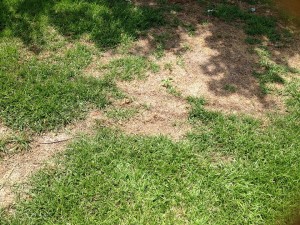Is yellow, dried out grass showing up on your lawn? You might have a grub infestation. Here’s what you need to know to correctly identify this problem, what you can do to stop it, and steps you can take to keep it from happening in the future.
Identifying a Grub Infestation
In the summer, beetles lay eggs on the ground which hatch into the grubs. Through the late summer and fall, the grubs eat as much as they can so they can survive the winter. Once cold temperatures hit, they burrow 4-8 inches into the soil to hibernate, reawakening in the spring. Their feeding resumes at a slower pace until they emerge as adult beetles in early summer. A few grubs in your soil is no cause for alarm, but major infestations can cause serious turf damage.
The grubs’ fall feeding frenzy can do major damage to the root system of your turf, creating yellow patches of grass on the surface. If other causes like high amounts of shade or lack of water have been ruled out, it’s likely that the cause is a grub infestation. Severe infestations will make the soil spongy and eventually break the connection between the sod and soil, allowing it to be peeled back like a piece of carpet. High concentrations of grubs will also attract predators including skunks, moles, and crows.
Fall is the best time to stop the infestation since the heightened activity makes these adolescent insects more likely to venture close to the surface of the soil and consume biological and chemical agents. There are several methods that can be used to reduce the population and prevent future infestations.
Physically Killing Grubs with Your Aerator
You can’t step on a grub like you would a spider since they’re buried in the soil, but your aerator can punch through the top layer and through the insect inside. Your lawn should always be moist to make it easier for the tines to penetrate the soil, but if you want the maximum effect on grubs, watering should be done the day before aerating to force them into upper soil layers where the tines can more easily reach them.
Overseeding
Grubs and the beetles that lay them prefer sparse lawns. Overseeding your lawn can make it harder for beetles to find an egg laying spot, and make it harder for the grubs to move around. In the northern half of the U.S, having both warm and cool weather grasses can help maintain a thick lawn across the egg laying and feeding seasons.
Dethatching
A thatch layer thicker than ¾ inch can keep grub treatments from reaching the ground, and thick thatch can encourage beetles to lay eggs. If you have heavy thatch build-up, remove it with a power rake before applying pesticides or nematodes.
Nematodes
A nematode is a microscopic, smooth worm which lives in soil and eats plants and insects. Plant-eating nematodes are a major threat to crops, but beneficial varieties are available that will actively hunt grubs. Steinernema bacteriophora (Sb) and Heterorhabditis bacteriophora (Hb) varieties can be used to treat lawn pests, but for grubs, Hb is the most effective. These worms can burrow deep into soil and have a mouth designed to bite into grubs.
The nematodes should be stored in a refrigerator before use, and should only be applied when the temperature is between 48-93°F (9-34°C.) The worms will need to be mixed with water and applied to the lawn using either a watering can or a garden sprayer; there are several ways to pack nematodes, so check the instructions on the correct mixing procedure. Rinse the lawn after application to wash off any nematodes stuck on the grass, then keep the lawn moist for the next two weeks to help the worms dig into the soil.
Pesticides
Trichlorfon or carbaryl-based pesticide can be applied to kill off remaining grubs. These pesticides are usually in granular form and will require light watering to work them into the soil without running off the turf.
Make Sure Your Equipment is Ready to Fight Pests
Billy Goat’s overseeders and dethatchers are invaluable tools when fighting off grubs, but only if they’re running right. When you need parts to repair or maintain your Billy Goat equipment, visit www.billygoatparts.com. We’re a certified dealer for Billy Goat and their manufacturing partners so we can provide you with everything you need including engine parts. We ship across the U.S. and Canada.

